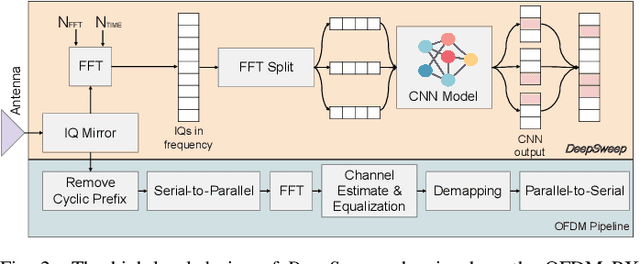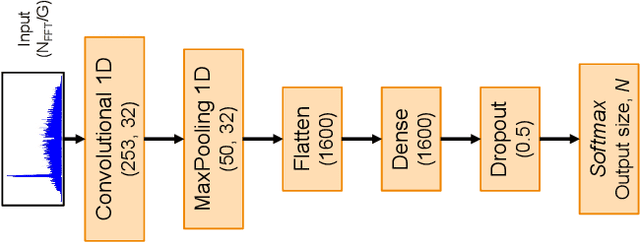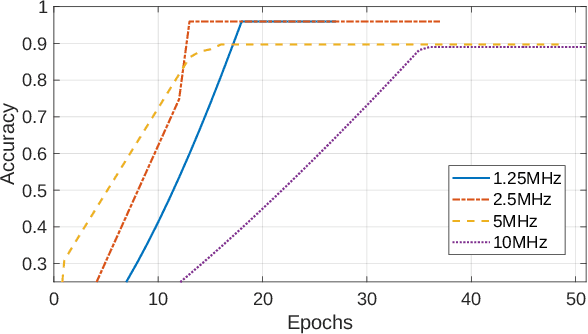Clifton Paul Robinson
Stitching the Spectrum: Semantic Spectrum Segmentation with Wideband Signal Stitching
Feb 07, 2024



Abstract:Spectrum has become an extremely scarce and congested resource. As a consequence, spectrum sensing enables the coexistence of different wireless technologies in shared spectrum bands. Most existing work requires spectrograms to classify signals. Ultimately, this implies that images need to be continuously created from I/Q samples, thus creating unacceptable latency for real-time operations. In addition, spectrogram-based approaches do not achieve sufficient granularity level as they are based on object detection performed on pixels and are based on rectangular bounding boxes. For this reason, we propose a completely novel approach based on semantic spectrum segmentation, where multiple signals are simultaneously classified and localized in both time and frequency at the I/Q level. Conversely from the state-of-the-art computer vision algorithm, we add non-local blocks to combine the spatial features of signals, and thus achieve better performance. In addition, we propose a novel data generation approach where a limited set of easy-to-collect real-world wireless signals are ``stitched together'' to generate large-scale, wideband, and diverse datasets. Experimental results obtained on multiple testbeds (including the Arena testbed) using multiple antennas, multiple sampling frequencies, and multiple radios over the course of 3 days show that our approach classifies and localizes signals with a mean intersection over union (IOU) of 96.70% across 5 wireless protocols while performing in real-time with a latency of 2.6 ms. Moreover, we demonstrate that our approach based on non-local blocks achieves 7% more accuracy when segmenting the most challenging signals with respect to the state-of-the-art U-Net algorithm. We will release our 17 GB dataset and code.
DeepSweep: Parallel and Scalable Spectrum Sensing via Convolutional Neural Networks
Jan 09, 2024



Abstract:Spectrum sensing is an essential component of modern wireless networks as it offers a tool to characterize spectrum usage and better utilize it. Deep Learning (DL) has become one of the most used techniques to perform spectrum sensing as they are capable of delivering high accuracy and reliability. However, current techniques suffer from ad-hoc implementations and high complexity, which makes them unsuited for practical deployment on wireless systems where flexibility and fast inference time are necessary to support real-time spectrum sensing. In this paper, we introduce DeepSweep, a novel DL-based transceiver design that allows scalable, accurate, and fast spectrum sensing while maintaining a high level of customizability to adapt its design to a broad range of application scenarios and use cases. DeepSweep is designed to be seamlessly integrated with well-established transceiver designs and leverages shallow convolutional neural network (CNN) to "sweep" the spectrum and process captured IQ samples fast and reliably without interrupting ongoing demodulation and decoding operations. DeepSweep reduces training and inference times by more than 2 times and 10 times respectively, achieves up to 98 percent accuracy in locating spectrum activity, and produces outputs in less than 1 ms, thus showing that DeepSweep can be used for a broad range of spectrum sensing applications and scenarios.
Colosseum as a Digital Twin: Bridging Real-World Experimentation and Wireless Network Emulation
Apr 13, 2023



Abstract:Wireless network emulators are being increasingly used for developing and evaluating new solutions for Next Generation (NextG) wireless networks. However, the reliability of the solutions tested on emulation platforms heavily depends on the precision of the emulation process, model design, and parameter settings. To address, obviate or minimize the impact of errors of emulation models, in this work we apply the concept of Digital Twin (DT) to large-scale wireless systems. Specifically, we demonstrate the use of Colosseum, the world's largest wireless network emulator with hardware-in-the-loop, as a DT for NextG experimental wireless research at scale. As proof of concept, we leverage the Channel emulation scenario generator and Sounder Toolchain (CaST) to create the DT of a publicly-available over-the-air indoor testbed for sub-6 GHz research, namely, Arena. Then, we validate the Colosseum DT through experimental campaigns on emulated wireless environments, including scenarios concerning cellular networks and jamming of Wi-Fi nodes, on both the real and digital systems. Our experiments show that the DT is able to provide a faithful representation of the real-world setup, obtaining an average accuracy of up to 92.5% in throughput and 80% in Signal to Interference plus Noise Ratio (SINR).
Narrowband Interference Detection via Deep Learning
Jan 23, 2023Abstract:Due to the increased usage of spectrum caused by the exponential growth of wireless devices, detecting and avoiding interference has become an increasingly relevant problem to ensure uninterrupted wireless communications. In this paper, we focus our interest on detecting narrowband interference caused by signals that despite occupying a small portion of the spectrum only can cause significant harm to wireless systems, for example, in the case of interference with pilots and other signals that are used to equalize the effect of the channel or attain synchronization. Due to the small sizes of these signals, detection can be difficult due to their low energy footprint, while greatly impacting (or denying completely in some cases) network communications. We present a novel narrowband interference detection solution that utilizes convolutional neural networks (CNNs) to detect and locate these signals with high accuracy. To demonstrate the effectiveness of our solution, we have built a prototype that has been tested and validated on a real-world over-the-air large-scale wireless testbed. Our experimental results show that our solution is capable of detecting narrowband jamming attacks with an accuracy of up to 99%. Moreover, it is also able to detect multiple attacks affecting several frequencies at the same time even in the case of previously unseen attack patterns. Not only can our solution achieve a detection accuracy between 92% and 99%, but it does so by only adding an inference latency of 0.093ms.
 Add to Chrome
Add to Chrome Add to Firefox
Add to Firefox Add to Edge
Add to Edge